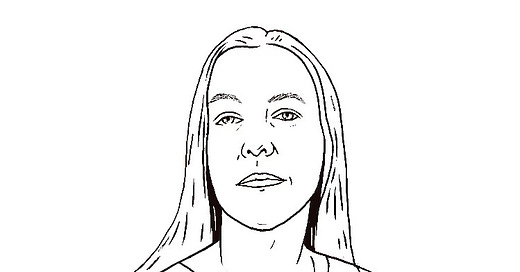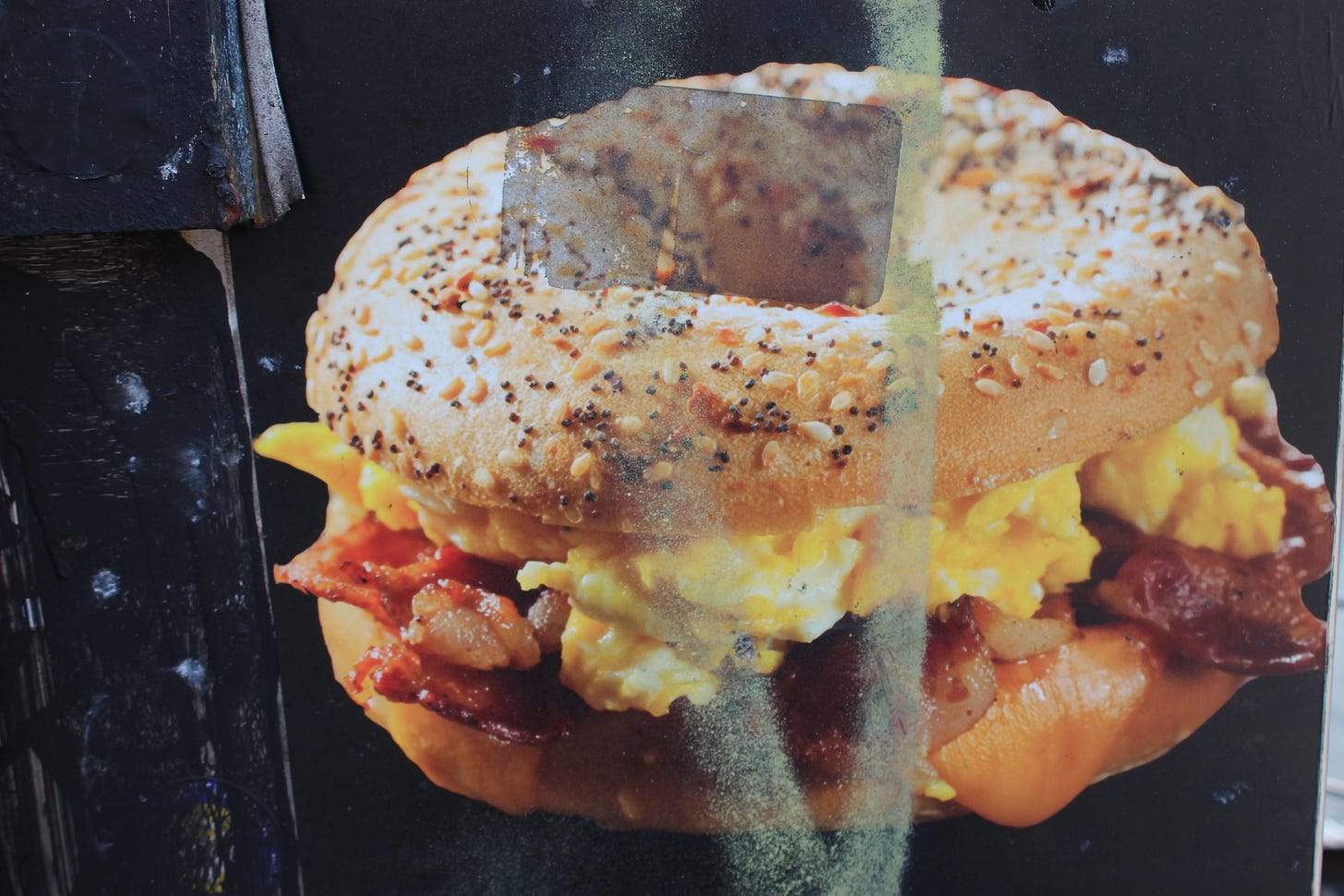New York’s been a blast. Last night we launched our new Compact podcast Blame Theory live at the KGB Bar—the Soviet kitsch a perfect backdrop for the premise of the show, namely to take seriously the power of ideas to shape material reality. How do thinkers and conceptual currents play out in the real world, and to what extent can we attribute “blame” to thoughts and those that propagate them? Are ideas merely symptoms of deeper economic and social processes? We live at the end and in the midst of hundreds of thoughts and their consequences—but we have some time to untangle them, we hope!
Geoff Shullenberger, Avital Ronell & Me, KGB Bar, Feb 29th 2024
Our first guest was Avital Ronell, NYU prof and author of, among many other books, The Telephone Book and Complaint. Ronell was on top form as representative of our first target of blame—deconstruction. Rolling through Nietzsche’s desert, German Romanticism, Derrida’s drugs bust in Czechoslovakia, and emails as gestures of mourning, Ronell was the ideal bearer of the necessity of tarrying with unintelligibility, ambivalance, ressentiment, patricide, and violence. We’ll put the episode out in due course, but the event was a great sign: There is real hunger for a shared intellectual life that is at once serious and playful. I’ve never felt more optimistic about culture: There’s life after anxiety! Or, you know, we can at least try to live together with a proportionate amount of it … thank you for coming, and they’ll be more events to come.
This week I visited the Brooklyn Museum with Compact fellow, Stephen Adubato, whose runs the excellent Substack, Cracks in Postmodernity. I decided to walk there from my hotel in Bowery, over the Manhattan Bridge, which was simultaneously lonely, terrifying and vertiginous. About halfway over I had to remind myself that it was very unlikely to crash into the East River, if only because it hadn’t so far.
When I eventually got there after walking along a main road in the rain for an hour or so (in retrospect I should have pounded some smaller, more humane, streets), we saw “Giants: Art from the Dean Collection of Swizz Beatz and Alicia Keys.” I had no idea that such a collection existed, but here it is, bookended by giant neo-aristocratic portraits of the couple by Kehinde Wiley. The emphasis of “Giants” was on capital-B Black artists, from the States but not only. Leaving aside the boiler-plate tombstones, which are apparently de rigueur for all galleries these days—everything must be relentlessly positive while also dismantling the white gaze and whatnot—there were some great pieces, among which, a large selection of Gordon Parks mid-century photographs, the late Kwame Brathwaite’s fashion images, and a Basquiat sketch which quietly questions the bureaucratic reification of race that dominates contemporary institutions.
One lesson I suppose we all have to learn is that there’s little point in demanding recognition (positive or negative) from those whose worldview you oppose, and even less point in demanding it from bureaucracy itself. Identity is not the same as character; the latter is a never-ending project, the former a tick box. An unstable identity is not a problem you can get others to solve, particularly if they’re too busy seeking their own recognition. Christopher Lasch is often invoked, but he’s right to pin down post-war narcissism as stemming from “quite specific changes in our society and culture—from bureaucracy, the proliferation of images, therapeutic ideologies, the rationalization of the inner life, the cult of consumption, and in the last analysis from changes in family life and from changing patterns of socialization.” A renaissance, instead, of the open-ended nature of character, personality, a recollection and embrace of social ties and duties, is overdue.
Mmmm
In other New York impressions, I was once again overcome by the extraordinary combinatorial excess of your things. I had not one, but two, coffees that combined balsamic vinegar and fig syrup, not because they were nice, but simply because they existed. I am forever reminded of mountaineer George Mallory’s response when asked why he wanted to climb Everest: “because it is there.” We’ll never know if Mallory made it to the top, but America shares something of this relentless quest for making everything that is possible manifest, even, or especially, when this “everything” is manifestly insane.
Latest pieces in Compact
We began the week with Christopher Bedford, who presents the historical context for today’s exploitation of children, pointing out that in the data age, it is children who “provide the unremunerated labor that helps power platforms like Tiktok and Instagram.” Describing ongoing battles between legislators and corporations, Bedford notes that we will continue to “wrestle with questions on how to control an economy that commodifies and hurts children.”
Tackling one of the most contentious political issues of the current moment, John Daniel Davidson in “How Christians Help Human Traffickers” argues that “helping the poor and welcoming the stranger doesn’t mean becoming complicit in what amounts to the largest human-trafficking operation in history.” Picking apart the complex of issues around charity and complicity in illegal people smuggling, Davidson concludes that “there is nothing compassionate, much less Christian, about helping to ensure the smugglers’ smooth operations.”
Photo: Jon McNaughton
Our art critic, Adam Lehrer takes on Jon McNaughton’s playful MAGA art/propaganda, noting that “elite aesthetic contempt…propelled the 45th president’s popularity among those dismissed as ‘deplorables.’” We are, though, already a long way past the moment when anything Trump-related was greeted with palpable horror. As Adam notes, “the vibe shift, however, is palpable, and the doubling down on the other side of it only affirms as much.” What will a post-Trump, post-Biden, possibly Trump again, art look like?
Thomas Fazi examined the European farmers’ revolts in “Let Them Eat Carbon,” arguing that “carbon farming will disproportionately hurt small farmers vis-à-vis large ones” and that, furthermore, the case for carbon farming is very weak, emerging as an idea “in those liminal spaces where ideology, class, and economic interests meet.” Without farmers, we have no basis for a sustainable life. I grew up in a rural part of the English countryside surrounded by working dairy farms. Very few city-dwellers have any idea how hard farming is, and how much small farmers in particular are squeezed by supermarkets and land-grabs. It should not surprise us at all that European farmers everywhere are protesting injustices against them.
To round out the week, we published Malcom Kyeyune on the need to restructure NATO, and two pieces criticizing what Compact founder Sohrab Ahmari calls corporate tyranny—Gord Magill on Canadian journalism’s complete abdication of seriousness, particularly around the treatment of truckers from the Freedom Convoy, and finally, Ben Burgis on “Big Business’s War on the New Deal”: “The labor laws enforced by the NLRB are extraordinarily weak compared to the rights held by workers in many other advanced capitalist nations.”
Finally, our long read for the weekend is Greg Conti on “The Roots of Right-Wing Progressivism”. Among many important points, Conti argues that “far from being a conservative country, the United States suffers greatly from the lack of any powerful and principled conservative force in its mainstream.” There’s a lot in this piece worth meditating on.
Nina Recommends
I was largely walking around New York this week, so I recommend that (maybe not the bridge bit), but I did belatedly watch Justine Triet’s Anatomy of a Fall (the dog did it…joking!), which was a great recent entry into the “let’s make films for adults about morally ambivalent women” category (cf. Todd Field’s Tar). We’ve finally got back to the ’90s understanding, found also in post-liberal fave Alasdair MacIntyre, that facts are also a type of story a culture tells itself. But first we have to remember how to read! As Avital Ronell puts it in Complaint, “One doesn’t have to look far beyond the universities and creative sites to see the ongoing battles waging, even as a distant rumble of resistance to reading and textual struggle makes itself heard in those places hosting critical thought on all levels of discernment, journalistic appropriation, popular makeovers, and social activism.”
To the books, once more, common-gooders! Until next week—Nina









Love your work!